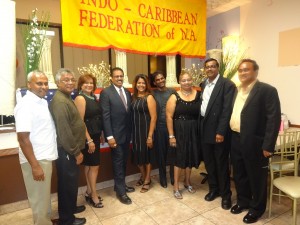By Sam Sooppersaud

On the evening of Thursday, September 26, 2013, the Indo-Caribbean Federation of North America held its annual Appreciation Dinner in Richmond Hill, New York. The affair was well attended and also well represented with members, sponsors, artistes and supporters from diverse walks of life. These are the people who consistently do the work of the organization, selflessly and with the utmost dedication. They all put in their time; hundreds of hours, freely without expecting anything in return. These are the people who ensure that our rich culture and heritage, customs and traditions are kept alive in this country-the USA- which we now call home.
‘What is the Indo-Caribbean Federation all about?’ one not familiar with the organisation may ask. Let me shed some light. In early 1984 several prominent members of the Indo community, originally from Guyana and Trinidad, leaders of the community, came together at an informal meeting to, sort of, get a perspective on Indo Caribbean, specifically, Guyanese immigrants, to the USA. The other purpose of the “get together” was to explore ways in which they could raise enough finances to assist Ms. Bhanu Dwarika in sustaining her ailing television programme.
Various matters were discussed, paramount of which was “how were the new Indo-Caribbean people faring and adjusting” to their new life in North America. What support organisations are around that they could turn to for advice? Being new immigrants, they could not afford to turn to professional entities for whatever help and advice they needed. After exploring all the related topics, the good men and women at that meeting saw the need for an organisation dedicated to stand on behalf of the Indo peoples.
The initial discussions on the formation of the ICF were done during 1984, but the formal incorporation was not done until February, 1985. The Federation was founded with the underlying goal of bringing together the people of Indian origin and background, regardless of the countries or villages from which they migrated. Special attention would be paid to the newly-arrived immigrants facing the many hardships of adjusting to their new environment. The aim of the ICF would be to work with those folks collectively to help alleviate the stress of “culture shock” they experienced.
The organisation set off on solid ground with the people in charge working diligently to accomplish its mission. The membership elected Rudra Nath as the President of the newly-formed ICF. He was one of the many people who had originally sat down and explored the idea of forming such an organisation. He and his newly-elected slate of officials set about getting the organisation exposed to the Indo-Caribbean people. They made it clear to those they met and spoke with that the Federation’s goal was to address the needs of the Indo-Caribbean community, be it legal, social, cultural, educational; whatever problems they faced or information they required, the ICF would be there, at their service. People would enjoy the help with documentation. The ICF set up various channels through which to pass on much needed information to the community.
The business of the ICF flowed smoothly, with lots of “elbow grease” expended by the hard-working folks. But, just when it’s seemed that the Federation was getting ahead, it experienced its first of many “dark days”, when fractionalisation raised its ugly face within the ranks.
I would agree that it was indeed difficult for people to spend very long hours doing voluntary work. The ICF needed workers to spend hundreds of hours to accomplish its commitments. The people holding key positions in the organisation and doing the work, although willing to make the sacrifices, were unable to allot the time necessary to spiral the organisation ahead. President, Rudra Nath tried his very best but could only accomplish so much. Small groups started to expound their own theories.
For nearly three years, the business of the ICF was placed on the back burner, where it remained dormant. It appeared that the leadership lost interest in the true motivation of the organisation. During this period, serious dissention arose among the membership. Groups of members were blaming other groups for the stagnation of the ICF. There was what we call in the old country “name-calling”. This state of affairs led to more negatives. Rudra was unable to pull the groups back together.
The next elected President, James Permaul, tried his very best to resuscitate the ailing Federation. But try as he did, he was not able to mobilise the membership and get the ICF train back on track. But he persisted in holding frequent meetings and airing the problems facing the ICF, from the outside, and among its ranks.
In 1991 Real Estate Executive, Ray Sundar, was elected to head the ICF. Under his presidency, the organisation enjoyed resurgence. Quoting from Isardat Ramdehal’s assessment of Ray’s work: “Ray Sundar brought about a new surge of energy, aggression, activities, and increased membership into the ICF.”
Numerous programmes were introduced and put in effect: publication of an ICF Newsletter, an educational conference, participation in an international cultural affair. Many other projects were introduced and if already started, continued to get the attention of the president and his team.
The annual cricket match between Guyana and Trinidad, the Talent Show and Beauty Pageant in Commemoration of Arrivals Day are just a few. Yes, Ray Sundar kept his hand on the ticker. The ICF was forging ahead accomplishing its goals. His term in office ended in 1992. Some look at this as being the end of ICF’s involvement in the community, at least for a couple of years.



